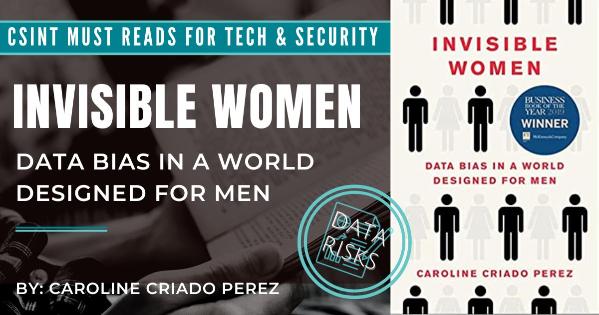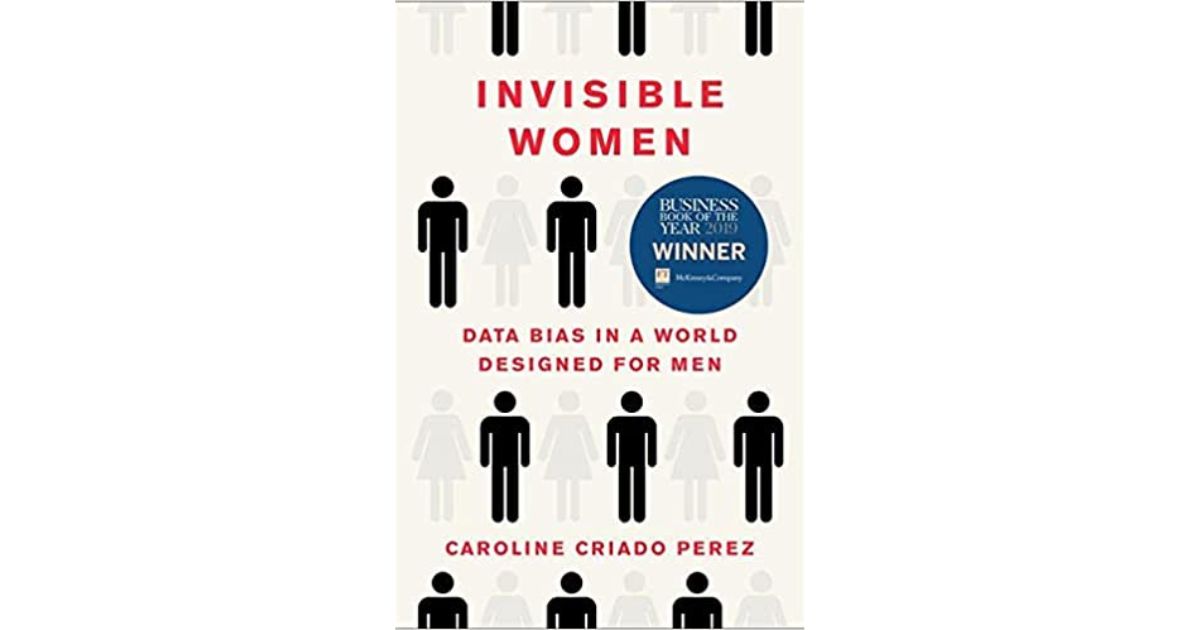Book Review - Invisible Women: Data Bias in a World Designed for Men

In her book, Invisible Women: Data Bias in a World Designed for Men, author and activist Caroline Criado Perez delves into the widespread data inequities between men and women. Through extensive research into data that quantifies women’s experiences in their homes, workplaces, and communities, Criado Perez exposes huge gaps in coverage and presents a compelling case that excluding the female experience costs time, money, and even lives.
Building on French philosopher and feminist activist Simone de Beauvoir’s Second Sex theory, Criado Perez introduces the reader to the concept of the Default Male. At its core, the Default Male represents the conscious and unconscious societal practice of treating men’s bodies and experiences as the model standard. Criado Perez asserts that due to this widely accepted norm, women’s bodies and experiences are treated as abnormalities, niche use cases, or, at best, afterthoughts. This societal default leaves a shortage of accurate and effective data on the female experience, leading to costly errors and miscalculations in policy decisions pillared on big data.
Criado Perez implores the reader to consider the far-reaching implications of this data gap for everything from traditional societies to those that heavily rely on data-driven machine learning. Organized in an approachable fashion, Invisible Women begins with case studies of women’s daily lives, then expands outwards throughout each section by highlighting the different roles women play in successively broader segments of society. The author neatly partitions these experiences into six interconnected areas of study: daily life, the workplace, product design, going to the doctor, public life, and ‘when it goes wrong’ – a final section exploring policy failures related to disasters. By employing this structure, Criado Perez emphasizes the exponential effect and rampant consequences for society as a whole of the lack of accurate data from women’s experiences.
Criado Perez’s strength lies in her ability to interweave quantitative and qualitative observations in a digestible format. By interspersing facts and statistics with quick and witty asides, she avoids swamping the reader in a soup of numbers. In this way, Criado Perez painlessly guides the reader through abundant research, evidence, and insights.
Criado Perez’s venture into the absence of data surrounding women’s health and bodies is the most compelling part of the book. The author cites clinical trials that do not include women, drug research that does not disaggregate results based on sex, and incorrect reference points and measurements for how life-threatening conditions may present in women, such as heart disease and adverse drug reactions. Women consume 80% of the pharmaceuticals in the United States, yet less than half of the prescription drugs available on the U.S. market have been analyzed for sex-based reactions. Additionally, Criado Perez acknowledges women’s societal obligations may expose them to more potentially life-threatening conditions to begin with, such as long-term exposure to smoke inhalation caused by poor ventilation and cooking fuels in developing countries.
The author’s choice to include case studies that veer on the unusual and obscure, such as snow-plowing and virtual reality headsets, shows how the absence of women’s data and experiences permeates aspects of life the reader may never have considered. These examples, combined with more commonly recognized differences, such as women being more likely to be cold in an office or women’s hands being too small to operate a smartphone as efficiently as the average man can, help support the author’s argument in breadth and depth.
Throughout the text, Criado Perez skillfully encourages the reader to reframe their mindset: what if instead of women’s hands being too small, smartphones were designed to be too big? Criado Perez recognizes that these biases to treat women’s experiences as ‘other’ exist in us all – sex aside. By articulating how even the most mundane differences have shocking impacts, the author forms new connections and offers insights that keep the reader engaged.
Alongside reframing, Criado Perez tackles failures in existing policy solutions and suggests corrective action. Similar to studies about the need for racial and ethnic diversity in decision-making, the book provides evidence of why equality is not the same as equity. Whether the subject at hand is gender-neutral clothing, equal square footage for men’s and women’s restrooms, or “average” car safety-testing dummies, Criado Perez’s book provides effective anecdotes and evidence that powerfully support her argument.
While the author recognizes in her introduction that identifiers beyond sex, such as gender identification, race, ethnicity, culture, and religion, can exacerbate differences in data accuracy, she limits her scope to sex. Through multiple case studies, Criado Perez makes a reasonable effort to include the experiences of Indian, Black American, and Muslim Bangladeshi women beyond the default of white, Protestant, and western women. However, there is still ample room for more diversified profiles in the text to further emphasize the potential harm in data that defaults to white men. Additionally, Criado Perez may have strengthened her argument by underscoring the effects of the sex data bias on emerging technologies such as machine learning and artificial intelligence that will be central to future operations and public policy.
In a 2020 epilogue, Criado Perez recognizes the unfortunate truths explored in her sixth section by reflecting on the Covid-19 pandemic. The author observes that the disaster has wreaked havoc on many, especially healthcare workers and caretakers who – you guessed it – are overwhelmingly women. In particular, the author cites that transitioning to remote schooling and work has exacerbated unpaid labor, 75% of which was provided by women even before the pandemic. Criado Perez’s epilogue highlights the real-world implications of implementing policies that ignore the unique position of women, therefore intensifying their struggles during unprecedented times.
Altogether, Invisible Women presents a provocative and convincing case for changing how society quantifies and includes women’s experiences. Everyone from the leisurely reader, to the academic scholar, to the responsible policymaker should consider Caroline Criado Perez’s recommendations to create an equitable and healthy society for all women.
About the Author:
Caroline Thompson is a current graduate student in the School of International Service's U.S. Foreign Policy and National Security Program. She is specializing in emerging technologies, cybersecurity, and national security. Caroline is interested in the intersection of artificial intelligence, big data, and private innovation with national security.
*THE VIEWS EXPRESSED HERE ARE STRICTLY THOSE OF THE AUTHOR AND DO NOT NECESSARILY REPRESENT THOSE OF THE CENTER OR ANY OTHER PERSON OR ENTITY AT AMERICAN UNIVERSITY.

